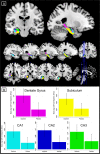Oxytocin modulates hippocampal perfusion in people at clinical high risk for psychosis
- PMID: 30626906
- PMCID: PMC6784972
- DOI: 10.1038/s41386-018-0311-6
Oxytocin modulates hippocampal perfusion in people at clinical high risk for psychosis
Abstract
Preclinical and human studies suggest that hippocampal dysfunction is a key factor in the onset of psychosis. People at Clinical High Risk for psychosis (CHR-P) present with a clinical syndrome that can include social withdrawal and have a 20-35% risk of developing psychosis in the next 2 years. Recent research shows that resting hippocampal blood flow is altered in CHR-P individuals and predicts adverse clinical outcomes, such as non-remission/transition to frank psychosis. Previous work in healthy males indicates that a single dose of intranasal oxytocin has positive effects on social function and marked effects on resting hippocampal blood flow. The present study examined the effects of intranasal oxytocin on hippocampal blood flow in CHR-P individuals. In a double-blind, placebo-controlled, crossover design, 30 CHR-P males were studied using pseudo-continuous Arterial Spin Labelling on 2 occasions, once after 40IU intranasal oxytocin and once after placebo. The effects of oxytocin on left hippocampal blood flow were examined in a region-of-interest analysis of data acquired at 22-28 and at 30-36 minutes post-intranasal administration. Relative to placebo, administration of oxytocin was associated with increased hippocampal blood flow at both time points (p = .0056; p = .034), although the effect at the second did not survive adjustment for the effect of global blood flow. These data indicate that oxytocin can modulate hippocampal function in CHR-P individuals and therefore merits further investigation as a candidate novel treatment for this group.
Conflict of interest statement
The authors declare no competing interests.
Figures



Similar articles
-
Neurochemical effects of oxytocin in people at clinical high risk for psychosis.Eur Neuropsychopharmacol. 2019 May;29(5):601-615. doi: 10.1016/j.euroneuro.2019.03.008. Epub 2019 Mar 28. Eur Neuropsychopharmacol. 2019. PMID: 30928180
-
Effects of diazepam on hippocampal blood flow in people at clinical high risk for psychosis.Neuropsychopharmacology. 2024 Aug;49(9):1448-1458. doi: 10.1038/s41386-024-01864-9. Epub 2024 Apr 24. Neuropsychopharmacology. 2024. PMID: 38658738 Free PMC article. Clinical Trial.
-
Connectome dysfunction in patients at clinical high risk for psychosis and modulation by oxytocin.Mol Psychiatry. 2024 May;29(5):1241-1252. doi: 10.1038/s41380-024-02406-x. Epub 2024 Jan 19. Mol Psychiatry. 2024. PMID: 38243074 Free PMC article. Clinical Trial.
-
Acute oxytocin effects in inferring others' beliefs and social emotions in people at clinical high risk for psychosis.Transl Psychiatry. 2020 Jun 22;10(1):203. doi: 10.1038/s41398-020-00885-4. Transl Psychiatry. 2020. PMID: 32572020 Free PMC article. Clinical Trial.
-
Increased hippocampal blood flow in people at clinical high risk for psychosis and effects of cannabidiol.Psychol Med. 2024 Apr;54(5):993-1003. doi: 10.1017/S0033291723002775. Epub 2023 Oct 17. Psychol Med. 2024. PMID: 37845827 Clinical Trial.
Cited by
-
Progression from being at-risk to psychosis: next steps.NPJ Schizophr. 2020 Oct 5;6(1):27. doi: 10.1038/s41537-020-00117-0. NPJ Schizophr. 2020. PMID: 33020486 Free PMC article. Review.
-
Pan-London Network for Psychosis-Prevention (PNP).Front Psychiatry. 2019 Oct 11;10:707. doi: 10.3389/fpsyt.2019.00707. eCollection 2019. Front Psychiatry. 2019. PMID: 31681029 Free PMC article.
-
Unlocking potential of oxytocin: improving intracranial lymphatic drainage for Alzheimer's disease treatment.Theranostics. 2024 Jul 15;14(11):4331-4351. doi: 10.7150/thno.98587. eCollection 2024. Theranostics. 2024. PMID: 39113801 Free PMC article.
-
Oxytocin in Women's Health and Disease.Front Endocrinol (Lausanne). 2022 Feb 15;13:786271. doi: 10.3389/fendo.2022.786271. eCollection 2022. Front Endocrinol (Lausanne). 2022. PMID: 35242106 Free PMC article. Review.
-
Reduced cortical cerebral blood flow in antipsychotic-free first-episode psychosis and relationship to treatment response.Psychol Med. 2023 Aug;53(11):5235-5245. doi: 10.1017/S0033291722002288. Epub 2022 Aug 25. Psychol Med. 2023. PMID: 36004510 Free PMC article.
References
-
- Davies C, Radua J, Cipriani A, Stahl D, Provenzani U, McGuire P, et al. Efficacy and acceptability of interventions for attenuated positive psychotic symptoms in individuals at clinical high risk of psychosis: a network meta-analysis. Front Psychiatry. 2018. https://www.frontiersin.org/article/10.3389/fpsyt.2018.00187/full - DOI - PMC - PubMed
-
- Devoe DJ, Peterson A, Addington J. Interventions and social functioning in youth at risk of psychosis: a systematic review and meta-analysis. Early Interv Psychiatry. 2018. http://academic.oup.com/schizophreniabulletin/article/doi/10.1093/schbul... - DOI - PubMed
Publication types
MeSH terms
Substances
Grants and funding
LinkOut - more resources
Full Text Sources
Medical

